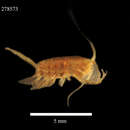Comprehensive Description
provided by Smithsonian Contributions to Zoology
Euchaeta calva (Tanaka, 1958)
Pareuchaeta calva Tanaka, 1958:347–548, fig. 71.
Pareuchaeta comosa Tanaka, 1958:363–365, fig. 79h–j [male only].
Euchaeta dudia.—Vervoort, 1963:176–181, figs. 21–23.
Pareuchaeta dubia.—Tanaka and Omori, 1967:245 [male only]; 1968:234 [male only].
Pareuchaeta Californica.—Tanaka and Omori, 1968:231–232, figs. 3e, 4e, 7a–c.
Pareuchaeta polita Tanaka and Omori, 1968–247, figs. 3o, 4o, 15a-d.
Pareuchaeta simulantis Tanaka and Omori, 1968:253–255, figs. 3w, 4w, 19a–f.
FEMALE.—Body length based on 86 specimens, 7.25–7.91 mm. Prosome length, 5.33–5.66 mm. Rostrum large, pointing obliquely forward (Figure 9a). Viewed laterally, genital prominence high and relatively narrow (Figure 9b). Length of genital flange (fl) 55–65/100 length of genital segment posterior to genital flange (sl). Posterior lobe of genital flange large, usually pointing posteroventrad. Antennule a little short of reaching distal end of prosome. Outer coxal lobe of maxillule with five large setae of similar size and a small seta of variable size in addition to 2 or 3 minute setae proximally (Figure 9e).
MALE.—Body length based on 11 specimens, 6.66-7.25 mm. Prosome length, 4.75–5.25 mm. Rostrum elongated, pointing downward (Figure 9h). Posterolateral corners asymmetrical, each with a toothlike process dorsally. Antennule reaching middle of second urosomal segment. Serrated lamella of second exopodal segment of left fifth leg rectangular, with a projection along external margin (Figure 9l). Uniformly small teeth bordering entire length of internal margin and distal portion of external margin. Digitiform process straight and shorter than serrated lamella, with a uniform thickness and round distal end (Figure 9n).
DISTRIBUTION.—Euchaeta calva has so far been known to occur in the Izu region, Middle Japan (Tanaka, 1958; Tanaka and Omori, 1967, 1968, as P. dubia), and in the Gulf of Guinea (Vervoort, 1963, as E. dubia). The records of E. dubia by DeDecker and Mombeck (1965) and Grice and Hulsemann (1967, 1968) from the Indian Ocean and the southeastern Pacific may also be referable to this species. In the present study, the species was represented by 86 females and 11 males, most of which were found in tows down to depths exceeding 1000 m. These findings constitute the first record of the species in the Gulf of Mexico and Caribbean Sea.
- bibliographic citation
- Park, Taisoo. 1975. "Calanoid copepods of the family Euchaetidae from the Gulf of Mexico and western Caribbean Sea." Smithsonian Contributions to Zoology. 1-26. https://doi.org/10.5479/si.00810282.196

